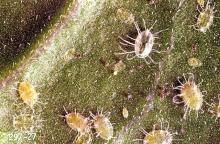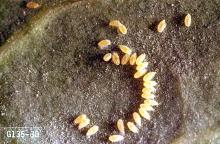Includes greenhouse whitefly (Trialeurodes vaporariorum)
Pest description and crop damage Adults resemble tiny white moths about 0.1 inch long. Immature forms look like scale insects and are completely sedentary after the first nymphal instar. Whiteflies occur in most potato fields by the season's end but rarely become very dense. They rarely, if ever, require control in PNW potatoes. In potatoes grown in greenhouse for seed, white flies can be a nuisance.
Biology and life history The greenhouse whitefly is a common pest of many crops and ornamental plants all over the world. Eggs are laid individually on leaves, the immature stages remaining on the same leaf throughout development. Therefore, larger whitefly nymphs will be found on mid-canopy leaves. The final immature stage is much like a pupa, with the adult developing inside the cast nymphal skin. Whiteflies have short generation times, with multiple generations per season.
Scouting and thresholds As noted above, whiteflies rarely reach populations requiring control, reducing the importance of including them in scouting programs. Adult whiteflies are easy to spot flying within the plant canopy. Whitefly nymphs are much more difficult to measure - a leaf sampling scheme is required since they are not dislodged during beating sheet/tray sampling. There is no established treatment threshold for whiteflies in PNW potatoes since they are not common in the region.
Management-biological control
Whiteflies are prey for many generalist predators as well as specific parasitoids. This may partially explain the infrequency with which they become abundant in PNW potatoes. In greenhouses, the parasitic wasp Encarsia formosa, which is commercially available, is an excellent biological control agent.
Management-chemical control: HOME USE
For best results, direct spray toward undersides of leaves. Read label application instructions carefully.
- acetamiprid
- azadirachtin (neem oil)-Some formulations are OMRI-listed for organic use.
- capsaicin-Some formulations are OMRI-listed for organic use.
- cyfluthrin
- deltamethrin
- esfenvalerate
- horticultural oil-Some formulations are OMRI-listed for organic use.
- insecticidal soap-May require several applications. Some formulations are OMRI-listed for organic use.
- kaolin-Applied as a spray to foliage it acts to repel certain insect pests. Some formulations are OMRI-listed for organic use.
- permethrin
- plant essential oils (e.g., clove, garlic, rosemary)-Have shown some efficacy against whitefly. Some formulations are OMRI-listed for organic use.
- pyrethrins (often as a mix with other ingredients)-Some formulations are OMRI-listed for organic use.
- zeta-cypermethrin
Management-chemical control: COMMERCIAL USE
See:




